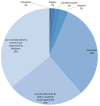Healthcare utilization and economic burden of myopia in urban China: A nationwide cost-of-illness study
- PMID: 35356656
- PMCID: PMC8934110
- DOI: 10.7189/jogh.12.11003
Healthcare utilization and economic burden of myopia in urban China: A nationwide cost-of-illness study
Abstract
Background: China contributes to a significant proportion of the myopia in the world. The study aims to investigate the utilization of various correction methods and health service in urban China, and to estimate the cost of myopia treatment and prevention. In addition, we aimed to estimate the cost of productivity loss due to myopia.
Methods: The study was a cross-sectional investigation carried out in urban areas in three provinces located in the east (Shanghai), middle (Anhui) and west part (Yunnan) of China, in 2016. A total of 23819 people aged between 5 to 50 years were included. Health utilization and the cost of myopia were analyzed from patients' perspective.
Results: The total number of people with myopia in the urban China was estimated to be 143.6 million. The correction rate was 89.5%, 92.1%, and 92.7% for Anhui, Shanghai, and Yunnan (χ2 = 19.5, P < 0.01). Over the recent year, 20.6%, 16.8%, and 28.8% of myopic subjects visited hospital due to myopia, in Anhui, Shanghai and Yunnan. The annual cost of treatment and prevention of myopia was 10.1 billion US dollar (US$, floating from 9.2 to 11.2 billion US$), and the cost per person was 69US$. The annual cost of loss of productivity was estimated to be 6.7 billion US$ for those with mild to moderate visual impairment (floating from 6.1 to 7.4 billion US$), and 9.4 billion US$ (floating from 8.5 to 10.4 billion US$) for those with severe visual impairment to blindness. Therefore, the total economic burden of myopia was estimated as 173.6 billion CNY (26.3 billion US$).
Conclusions: The present study shows that myopia leads to substantial economic burden in China. The loss of productivity caused by myopia is an important part of the disease burden compared to the cost of correction and treatment paid by individuals. Therefore, the focus of myopia prevention and control should be to decrease the myopia prevalence, and prevent the uncorrected refractive errors and the irreversible damage of visual acuity by high myopia.
Copyright © 2022 by the Journal of Global Health. All rights reserved.
Conflict of interest statement
Competing interests: The authors completed the ICMJE Declaration of Interest Form (available upon request from the corresponding author), and declare no conflicts of interest.
Figures




Similar articles
-
Potential Lost Productivity Resulting from the Global Burden of Myopia: Systematic Review, Meta-analysis, and Modeling.Ophthalmology. 2019 Mar;126(3):338-346. doi: 10.1016/j.ophtha.2018.10.029. Epub 2018 Oct 17. Ophthalmology. 2019. PMID: 30342076
-
Current estimates of the economic burden of blindness and visual impairment in India: A cost of illness study.Indian J Ophthalmol. 2022 Jun;70(6):2141-2145. doi: 10.4103/ijo.IJO_2804_21. Indian J Ophthalmol. 2022. PMID: 35648000 Free PMC article.
-
Refractive surgery: the most cost-saving technique in refractive errors correction.Int J Ophthalmol. 2018 Jun 18;11(6):1013-1019. doi: 10.18240/ijo.2018.06.20. eCollection 2018. Int J Ophthalmol. 2018. PMID: 29977817 Free PMC article.
-
[Estimating the disease burden of seasonal influenza in China, 2006-2019].Zhonghua Yi Xue Za Zhi. 2021 Mar 2;101(8):560-567. doi: 10.3760/cma.j.cn112137-20201210-03323. Zhonghua Yi Xue Za Zhi. 2021. PMID: 33663186 Chinese.
-
Myopia, an underrated global challenge to vision: where the current data takes us on myopia control.Eye (Lond). 2014 Feb;28(2):142-6. doi: 10.1038/eye.2013.256. Epub 2013 Dec 20. Eye (Lond). 2014. PMID: 24357836 Free PMC article. Review.
Cited by
-
Application of the 2021 AAPOS Guidelines in Clinics with Revision and Validation of SPOT Referral Criteria.Clin Ophthalmol. 2025 Jan 25;19:291-299. doi: 10.2147/OPTH.S488084. eCollection 2025. Clin Ophthalmol. 2025. PMID: 39882394 Free PMC article.
-
Causal effects of allergic diseases on the risk of myopia: a two-sample Mendelian randomization study.Eye (Lond). 2025 Jun;39(9):1812-1816. doi: 10.1038/s41433-025-03749-7. Epub 2025 Mar 22. Eye (Lond). 2025. PMID: 40121349
-
Diversified Segmental Defocus Optimization Lenses With and Without Atropine for Myopia Prevention: A Randomized Clinical Trial.JAMA Ophthalmol. 2025 Aug 1;143(8):684-691. doi: 10.1001/jamaophthalmol.2025.2072. JAMA Ophthalmol. 2025. PMID: 40638107 Clinical Trial.
-
Accurate prediction of myopic progression and high myopia by machine learning.Precis Clin Med. 2024 Mar 4;7(1):pbae005. doi: 10.1093/pcmedi/pbae005. eCollection 2024 Mar. Precis Clin Med. 2024. PMID: 38558949 Free PMC article.
-
Effect and safety posterior scleral reinforcement on controlling myopia in children: a meta-analysis.Int Ophthalmol. 2024 Feb 6;44(1):8. doi: 10.1007/s10792-024-02929-w. Int Ophthalmol. 2024. PMID: 38319543 Free PMC article.
References
MeSH terms
LinkOut - more resources
Full Text Sources
